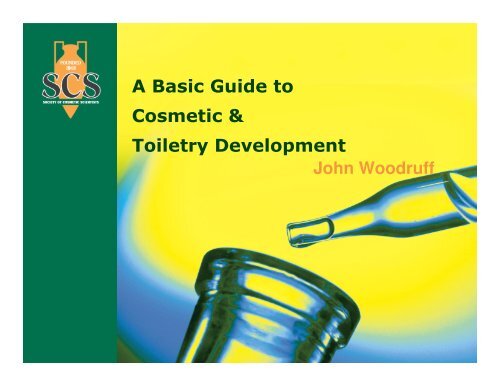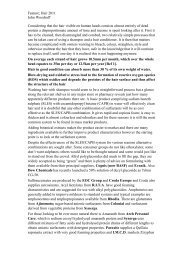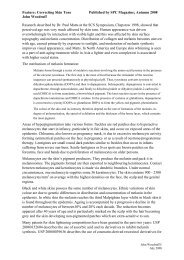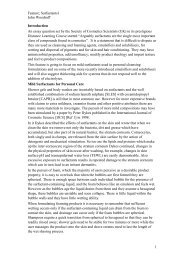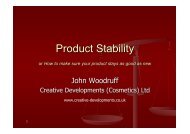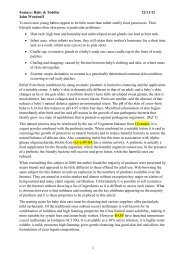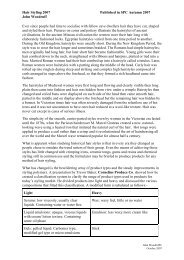A basic guide to cosmetic formulation - Creative Developments
A basic guide to cosmetic formulation - Creative Developments
A basic guide to cosmetic formulation - Creative Developments
You also want an ePaper? Increase the reach of your titles
YUMPU automatically turns print PDFs into web optimized ePapers that Google loves.
A Basic Guide <strong>to</strong><br />
Cosmetic &<br />
Toiletry Development<br />
John Woodruff<br />
john.woodruff@creative-developments.co.uk 1
A Basic Guide <strong>to</strong><br />
Formulating Cosmetics & Toiletries<br />
<br />
<br />
<br />
<br />
What is a <strong>cosmetic</strong>?<br />
Understanding product briefs<br />
From concept <strong>to</strong> product <strong>formulation</strong><br />
Sources of information<br />
EU <strong>cosmetic</strong> regulations<br />
The global marketplace<br />
Cost effective <strong>formulation</strong><br />
Product stability & preservation<br />
Example <strong>formulation</strong> techniques<br />
john.woodruff@creative-developments.co.uk 2
A Basic Guide <strong>to</strong><br />
Formulating Cosmetics & Toiletries<br />
What is a <strong>cosmetic</strong>?<br />
Understanding product briefs<br />
From concept <strong>to</strong> product <strong>formulation</strong><br />
Sources of information<br />
EU <strong>cosmetic</strong> regulations<br />
The global marketplace<br />
Cost effective <strong>formulation</strong><br />
Product stability & preservation<br />
Example <strong>formulation</strong> techniques<br />
john.woodruff@creative-developments.co.uk 3
What is a <strong>cosmetic</strong> product?<br />
European Regulations specify 6 functions for<br />
<strong>cosmetic</strong> products, namely:-<br />
<br />
<br />
<br />
<br />
<br />
<br />
<strong>to</strong> perfume<br />
<strong>to</strong> clean<br />
<strong>to</strong> change the appearance<br />
<strong>to</strong> protect<br />
<strong>to</strong> keep in good condition<br />
<strong>to</strong> correct body odours<br />
john.woodruff@creative-developments.co.uk 4
To perfume<br />
<br />
<br />
<br />
<br />
<br />
<br />
<br />
<br />
Perfume<br />
Toilet waters<br />
Mists & sprays<br />
Aromatherapy preparations<br />
Bath additives<br />
Shower gels<br />
Deodorants<br />
Body lotions<br />
These products<br />
should<br />
not penetrate the skin<br />
but perfume<br />
compounds<br />
including essential<br />
oils may do so.<br />
john.woodruff@creative-developments.co.uk 5
To clean<br />
<br />
<br />
<br />
<br />
<br />
<br />
<br />
<br />
Soap<br />
Syndet bars<br />
Bath additives<br />
Shower gels<br />
Cleansing emulsions<br />
Scrubs<br />
Cleansing masks<br />
Shampoos<br />
These products should<br />
not penetrate the skin<br />
but they do affect the<br />
skin surface (Stratum<br />
corneum – SC), they<br />
can remove skin lipids,<br />
affect skin barrier<br />
properties, increase<br />
cell turn- over, change<br />
pH & cause loss of<br />
moisture<br />
john.woodruff@creative-developments.co.uk 6
To change the appearance<br />
<br />
<br />
<br />
<br />
<br />
Decorative <strong>cosmetic</strong>s<br />
Foundation creams<br />
Blushers<br />
Lipsticks & eye shadows<br />
Fake tans<br />
Cover fine lines & wrinkles<br />
Plump out fine lines & wrinkles*<br />
Freeze facial muscles*<br />
DHA tanning*<br />
Skin lightening*<br />
These products should<br />
not penetrate the skin.<br />
*These products need<br />
<strong>to</strong> penetrate the S.C.<br />
john.woodruff@creative-developments.co.uk 7
To protect<br />
<br />
<br />
<br />
Sun protection<br />
Barrier creams<br />
Antiseptic washes<br />
These products should<br />
not penetrate the skin.<br />
<br />
<br />
Anti-oxidants*<br />
Protect immune system*<br />
*These products need<br />
<strong>to</strong> penetrate the S.C.<br />
john.woodruff@creative-developments.co.uk 8
To keep in good condition<br />
<br />
<br />
<br />
<br />
Moisturise<br />
Occlusive film<br />
Humectants<br />
NMF*<br />
Anti-oxidants*<br />
Support immune system*<br />
Plump out fine lines & wrinkles*<br />
NMF = Urea, cholesterol,<br />
sodium lactate, lactic acid,<br />
amino acids, phospholipids,<br />
sodium PCa, water<br />
*Generally these<br />
products need <strong>to</strong><br />
penetrate the S.C.<br />
john.woodruff@creative-developments.co.uk 9
To correct body odours<br />
<br />
<br />
<br />
Deodorants<br />
Antiperspirants<br />
Cleansing*<br />
e.g.washing<br />
These products should<br />
not penetrate the skin.<br />
*These products may<br />
affect the S.C.<br />
john.woodruff@creative-developments.co.uk 10
Field of application<br />
The field of application of <strong>cosmetic</strong>s is <strong>to</strong><br />
one or more of the following:<br />
the epidermis<br />
the hair system<br />
the nails<br />
the lips<br />
the external genital organs<br />
the teeth<br />
the mucous membranes of the oral cavity<br />
john.woodruff@creative-developments.co.uk 11
A Basic Guide <strong>to</strong><br />
Formulating Cosmetics & Toiletries<br />
Field of<br />
Application –<br />
anywhere<br />
visible, with<br />
or without<br />
swimming costumes<br />
john.woodruff@creative-developments.co.uk 12
A Basic Guide <strong>to</strong><br />
Formulating Cosmetics & Toiletries<br />
What is a <strong>cosmetic</strong>?<br />
Understanding product briefs<br />
From concept <strong>to</strong> product <strong>formulation</strong><br />
Sources of information<br />
EU <strong>cosmetic</strong> regulations<br />
The global marketplace<br />
Cost effective <strong>formulation</strong><br />
Product stability & preservation<br />
Example <strong>formulation</strong> techniques<br />
john.woodruff@creative-developments.co.uk 13
A Basic Guide <strong>to</strong><br />
Formulating Cosmetics & Toiletries<br />
The Brief<br />
A clear concise document produced by the<br />
marketing department after extensive<br />
market research with intended claims<br />
clearly defined.<br />
Or<br />
Woolly description full of pitfalls like<br />
“Natural” & “Organic” and claims changing<br />
as new ideas occur <strong>to</strong> origina<strong>to</strong>r.<br />
john.woodruff@creative-developments.co.uk 14
A Basic Guide <strong>to</strong><br />
Formulating Cosmetics & Toiletries<br />
The Packaging<br />
Already identified and selected as the<br />
ideal pack form <strong>to</strong> contain and deliver the<br />
product.<br />
Or<br />
To be decided!<br />
<br />
Usually after 2 months stability testing on a<br />
product with a quite unsuitable rheology for the<br />
final pack choice.<br />
john.woodruff@creative-developments.co.uk 15
A Basic Guide <strong>to</strong><br />
Formulating Cosmetics & Toiletries<br />
<br />
<br />
The Bench Mark<br />
An exciting & innovative product with clear<br />
functional benefits & with a similar selling price <strong>to</strong><br />
the product required.<br />
Or<br />
Two or three <strong>to</strong>tally different products, all 3x the<br />
selling price of the product required.<br />
Does the bench mark meet the product<br />
requirements?<br />
Claims, market niche, legislation?<br />
john.woodruff@creative-developments.co.uk 16
A Basic Guide <strong>to</strong><br />
Formulating Cosmetics & Toiletries<br />
<br />
<br />
The Time Table<br />
A program agreed between all concerned,<br />
allowing sufficient time for <strong>formulation</strong>, testing and<br />
proceeding <strong>to</strong> manufacture via pilot scale batches.<br />
Or<br />
Marketing has a slot promised by a major s<strong>to</strong>re 5<br />
months ahead. That is plenty of time surely!<br />
<br />
Remember <strong>formulation</strong>s can fail at any<br />
stage.<br />
john.woodruff@creative-developments.co.uk 17
Tip<br />
Read the brief and also read between the<br />
lines:<br />
If “natural” claims then reduce non-naturals<br />
<strong>to</strong> a minimum & no animal ingredients<br />
If “organic” avoid all proscribed ingredients<br />
<br />
E.g. Ethoxylated materials<br />
Most preservatives / colours / minerals /<br />
petroleum-based materials etc.etc.<br />
john.woodruff@creative-developments.co.uk 18
Tip<br />
<br />
<br />
Read the brief and also read between the lines:<br />
If one cus<strong>to</strong>mer, obey special requirements<br />
If for sensitive areas, mucous membranes etc.<br />
avoid unsuitable colours & preservatives<br />
Mucous membranes<br />
in the vicinity of the eyes<br />
on the lips<br />
in the oral cavity<br />
on the external genital organs<br />
john.woodruff@creative-developments.co.uk 19
Tip<br />
<br />
Read the brief and also read between the lines:<br />
Identify target consumer<br />
<br />
<br />
<br />
Young – greasy, acne<br />
Cleanse, <strong>to</strong>ne & leave alone<br />
Old – mature, dry, sensitive, lacking radiance &<br />
resilience<br />
Cleanse, desquamate, moisturise, cover up<br />
Middle – combination skin<br />
Protect & moisturise<br />
john.woodruff@creative-developments.co.uk 20
A Basic Guide <strong>to</strong><br />
Formulating Cosmetics & Toiletries<br />
What is a <strong>cosmetic</strong>?<br />
Understanding product briefs<br />
<br />
From concept <strong>to</strong> product <strong>formulation</strong><br />
<br />
<br />
<br />
<br />
<br />
Sources of information<br />
EU <strong>cosmetic</strong> regulations<br />
The global marketplace<br />
Cost effective <strong>formulation</strong><br />
Product stability & preservation<br />
Example <strong>formulation</strong> techniques<br />
john.woodruff@creative-developments.co.uk 21
Sources of Information<br />
Look at the bench mark & competi<strong>to</strong>rs products?<br />
Do they deliver their claims?<br />
If so how?<br />
<strong>cosmetic</strong>sdesign-europe.com<br />
Chemidex.com<br />
Cosmeticsbusiness.com<br />
Suppliers representatives & web sites<br />
Trade press & relevant articles<br />
Conference presentations<br />
Patent literature<br />
Text books<br />
john.woodruff@creative-developments.co.uk 22
A Basic Guide <strong>to</strong><br />
Formulating Cosmetics & Toiletries<br />
What is a <strong>cosmetic</strong>?<br />
Understanding product briefs<br />
From concept <strong>to</strong> product <strong>formulation</strong><br />
Sources of information<br />
EU <strong>cosmetic</strong> regulations<br />
The global marketplace<br />
Cost effective <strong>formulation</strong><br />
Product stability & preservation<br />
Example <strong>formulation</strong> techniques<br />
john.woodruff@creative-developments.co.uk 23
The Regulations<br />
Ignore at your peril<br />
EU 76/768/EEC – The 7 th Amendment<br />
And all subsequent amendments<br />
The Cosmetic Products (Safety)<br />
Regulations 2004 SI 2185<br />
Cus<strong>to</strong>mer-specific requirements<br />
<br />
e.g. Boots GR-10<br />
john.woodruff@creative-developments.co.uk 24
The Regulations<br />
<br />
<br />
<br />
<br />
<br />
<br />
<br />
EU 76/768/EEC – The 7 th Amendment<br />
It lists those materials that <strong>cosmetic</strong>s must not<br />
contain<br />
Those materials subject <strong>to</strong> restrictions in field of<br />
application and/or maximum allowed %<br />
A positive list of colours<br />
A positive list of antiperspirant materials<br />
A positive list of preservatives<br />
A positive list of UV absorbers<br />
john.woodruff@creative-developments.co.uk 25
Mucous membranes<br />
Be aware<br />
More prone <strong>to</strong> irritant reactions<br />
Restrictions on colours<br />
Restrictions on preservatives<br />
More stringent microbial rules<br />
Only ingestible products i.e.those with<br />
A.D.I., should be applied <strong>to</strong> the lips<br />
Tip - match pH <strong>to</strong> area of application e.g.<br />
Eyes are 7+/- 0.2 / Skin is ~5.3<br />
john.woodruff@creative-developments.co.uk 26
A Basic Guide <strong>to</strong><br />
Formulating Cosmetics & Toiletries<br />
What is a <strong>cosmetic</strong>?<br />
Understanding product briefs<br />
From concept <strong>to</strong> product <strong>formulation</strong><br />
Sources of information<br />
EU <strong>cosmetic</strong> regulations<br />
The global marketplace<br />
Cost effective <strong>formulation</strong><br />
Product stability & preservation<br />
Example <strong>formulation</strong> techniques<br />
john.woodruff@creative-developments.co.uk 27
Formulating Cosmetics & Toiletries for the<br />
Global Marketplace<br />
EU / USA / Japan / Brazil etc.<br />
Each area has own regulations<br />
<br />
<br />
Particularly affecting<br />
Colours<br />
Preservatives<br />
Antiperspirants<br />
Sunscreens<br />
Also<br />
Labelling<br />
Names of ingredients<br />
john.woodruff@creative-developments.co.uk 28
A Basic Guide <strong>to</strong><br />
Formulating Cosmetics & Toiletries<br />
What is a <strong>cosmetic</strong>?<br />
Understanding product briefs<br />
From concept <strong>to</strong> product <strong>formulation</strong><br />
Sources of information<br />
EU <strong>cosmetic</strong> regulations<br />
The global marketplace<br />
Cost effective <strong>formulation</strong><br />
Product stability & preservation<br />
Example <strong>formulation</strong> techniques<br />
john.woodruff@creative-developments.co.uk 29
Cost effective <strong>formulation</strong> of<br />
Cosmetics & Toiletries<br />
Start with current material inven<strong>to</strong>ry<br />
Don’t add cost without adding value<br />
<br />
Colin Hession<br />
Keep it simple – but effective<br />
Look at methods of production<br />
Process plant availability<br />
Heating costs / cooling costs / mixing costs<br />
/ processing time costs<br />
Fill using current machinery<br />
john.woodruff@creative-developments.co.uk 30
Tip<br />
<br />
Think commercially<br />
Use materials that are already in current s<strong>to</strong>ck<br />
wherever possible<br />
Use labora<strong>to</strong>ry mixing equipment which<br />
represents that available in the fac<strong>to</strong>ry<br />
Think of the likely batch sizes<br />
<br />
Can they be made with existing equipment?<br />
If there is a problem can the formula be revised?<br />
Can the product be filled with existing equipment?<br />
john.woodruff@creative-developments.co.uk 31
Tips<br />
Use labora<strong>to</strong>ry mixing equipment which<br />
represents that available in the fac<strong>to</strong>ry<br />
john.woodruff@creative-developments.co.uk 32
Tips<br />
Use labora<strong>to</strong>ry<br />
mixing equipment<br />
which represents<br />
that available<br />
in the fac<strong>to</strong>ry<br />
john.woodruff@creative-developments.co.uk 33
A Basic Guide <strong>to</strong><br />
Formulating Cosmetics & Toiletries<br />
What is a <strong>cosmetic</strong>?<br />
Understanding product briefs<br />
From concept <strong>to</strong> product <strong>formulation</strong><br />
Sources of information<br />
EU <strong>cosmetic</strong> regulations<br />
The global marketplace<br />
Cost effective <strong>formulation</strong><br />
Product stability & preservation<br />
Example <strong>formulation</strong> Techniques<br />
john.woodruff@creative-developments.co.uk 34
Stability and preservation of<br />
Cosmetics & Toiletries<br />
Preservative choice affected by<br />
Regulations<br />
Type of product<br />
<br />
Leave-on or Wash-off?<br />
pH of product<br />
pH < 6 / pH > 7<br />
Other ingredients<br />
<br />
<br />
Parabens inactivated by ethoxylates<br />
Phenoxyethanol thins many emulsions<br />
john.woodruff@creative-developments.co.uk 35
Stability and preservation of<br />
Cosmetics & Toiletries<br />
<br />
Stability checking is essential<br />
Minimal requirements are stability testing at 4C /<br />
RT / 40C for 3 months plus light where applicable<br />
<br />
<br />
<br />
<br />
<br />
<br />
45C used by some companies<br />
Freeze / thaw cycles<br />
Test in final packaging<br />
A product should remain stable for minimal 36 months at<br />
RT<br />
Continuing preservative efficacy over testing period is<br />
essential<br />
PAO = Period After Opening – depends on product type<br />
and packaging<br />
john.woodruff@creative-developments.co.uk 36
Tip<br />
Decide which preservatives can or cannot be<br />
used<br />
<br />
<br />
Talk <strong>to</strong> marketing. Talk <strong>to</strong> microbiologist<br />
<br />
The choice could affect your product stability<br />
Make selection of perfume a priority<br />
<br />
Talk <strong>to</strong> marketing and talk <strong>to</strong> the supplier<br />
<br />
The choice could affect your product stability<br />
If possible incorporate these two items in<br />
development samples from the outset<br />
john.woodruff@creative-developments.co.uk 37
A Basic Guide <strong>to</strong><br />
Formulating Cosmetics & Toiletries<br />
Formulation Techniques<br />
john.woodruff@creative-developments.co.uk 38
A Basic Guide <strong>to</strong><br />
Formulating Cosmetics & Toiletries<br />
Cosmetic functions<br />
<strong>to</strong> perfume<br />
<strong>to</strong> clean<br />
<strong>to</strong> change the appearance<br />
<strong>to</strong> protect<br />
<strong>to</strong> keep in good condition<br />
<strong>to</strong> correct body odours<br />
john.woodruff@creative-developments.co.uk 39
A Basic Guide <strong>to</strong><br />
Formulating Cosmetics & Toiletries<br />
Functional products are those for which a<br />
claim can be made, and which meet that<br />
claim.<br />
They consist of the vehicle and the active<br />
ingredient(s).<br />
The two parts must be compatible and the<br />
final product must be pleasant <strong>to</strong> use.<br />
john.woodruff@creative-developments.co.uk 40
Claims substantiation<br />
<br />
<br />
All proposed claims and methods of<br />
substantiation should be agreed at the start of<br />
product development so that a clear justification<br />
of claims can be provided from controlled<br />
labora<strong>to</strong>ry trials.<br />
User trial results (responses from 50 people) or<br />
raw material data or a combination of the above<br />
can be used.<br />
<br />
From Boots document <strong>to</strong> own label suppliers<br />
john.woodruff@creative-developments.co.uk 41
Functional skin care<br />
<br />
<br />
The vehicle and the active ingredient(s).<br />
The two parts must be compatible and the<br />
final product must be pleasant <strong>to</strong> use.<br />
Which comes first?<br />
Depends on many fac<strong>to</strong>rs<br />
<br />
<br />
<br />
Product form<br />
Packaging<br />
Claim<br />
john.woodruff@creative-developments.co.uk 42
A Basic Guide <strong>to</strong><br />
Formulating Cosmetics & Toiletries<br />
To keep in good condition<br />
Remove dead skin cells<br />
Protect from UV radiation<br />
Support immune system<br />
Protect from free radical species /ROS<br />
Replace lost lipids<br />
Moisturise<br />
john.woodruff@creative-developments.co.uk 43
A Basic Guide <strong>to</strong><br />
Formulating Cosmetics & Toiletries<br />
<br />
Narrowing the choice<br />
Cost<br />
Supporting the claim<br />
<br />
<br />
Check that claim support data is realistic and believable<br />
Will the product support the level of use on which claims<br />
data is based?<br />
Compatibility with vehicle<br />
Compatibility with packaging<br />
Safety assessment<br />
Patent search<br />
john.woodruff@creative-developments.co.uk 44
To keep in<br />
good<br />
condition<br />
Wash<br />
Scrub<br />
Remove dead skin cells<br />
Tape stripping!<br />
Peels including enzymes e.g. Papain<br />
Alpha hydroxy acids – AHAs<br />
<br />
Glycolic acid / citric acid / lactic acid / malic acid<br />
/ salicylic acid<br />
Fruit acids<br />
john.woodruff@creative-developments.co.uk 45
AHAs: Selecting the active<br />
<br />
Glycolic acid / citric acid / lactic acid / malic acid / salicylic acid<br />
<br />
Proprietary mixtures e.g. Acifruc<strong>to</strong>l Complex ex Gattefosse<br />
Aqua (Water)<br />
Citric Acid<br />
Citrus Grandis (Grapefruit) Fruit Extract<br />
Citrus Medica Limonum Extract<br />
Lactic Acid<br />
Malic Acid<br />
Propylene Glycol<br />
Solanum Lycopersicum (Toma<strong>to</strong>) Extract<br />
Vaccinium Myrtillus (Bilberry) Extract<br />
john.woodruff@creative-developments.co.uk 46
AHAs: Safety & legal issues<br />
<br />
<br />
The CIR Expert Panel concluded that glycolic and lactic<br />
Acid are safe for use in <strong>cosmetic</strong> products at<br />
concentrations 3.5<br />
Boots recommendations<br />
Glycolic acid must be less than 4% in formula and<br />
pH of final product must be > 3.8.<br />
Lactic acid must be less than 2.5% in formula and<br />
pH of final product must be > 5.<br />
If <strong>to</strong>tal AHAs are more than 4% then wording<br />
must appear on pack recommending<br />
consumers use products with AHAs in<br />
conjunction with sunscreen products.<br />
john.woodruff@creative-developments.co.uk 47
AHAs: Selecting the active<br />
Possible choice<br />
Glycolic acid<br />
Plus proprietary mixture<br />
<br />
Combines effectiveness with natural claims<br />
john.woodruff@creative-developments.co.uk 48
AHAs: Designing the vehicle<br />
Parameters<br />
pH 4 – 5<br />
Electrolytes<br />
Low oil content<br />
Penetration required<br />
Possible forms<br />
o/w emulsion<br />
foaming mousse<br />
light scrub<br />
john.woodruff@creative-developments.co.uk 49
AHAs: Designing the vehicle<br />
<br />
o/w emulsion<br />
Emulsifier suitable for pH 4 – 5<br />
Oil or ester resistant <strong>to</strong> acid hydrolysis<br />
Penetration enhancer ?<br />
<br />
Balance efficacy against safety<br />
Urea or ethoxydiglycol<br />
Or soften SC with emollients<br />
Anti-irritation ingredient e.g. Bisabolol<br />
Perfume / Preservatives / Rheology modifier<br />
john.woodruff@creative-developments.co.uk 50
AHAs: Possible <strong>formulation</strong><br />
3.00% Glyceryl stearate<br />
1.00% PEG-100 stearate<br />
3.00% Caprylic / capric triglyceride<br />
1.00% Paraffinum liquidum<br />
Aqua <strong>to</strong> 100%<br />
0.05% Disodium EDTA<br />
2.50% Glycolic acid<br />
3.00% Mixed fruit acids<br />
5.00% Ethoxydiglycol<br />
0.50% Bisabolol<br />
0.20% Xanthan gum<br />
Fragrance<br />
Preservatives e.g. Methyl + propyl paraben<br />
pH adjusted <strong>to</strong> 3.8 – 4.3<br />
john.woodruff@creative-developments.co.uk 51
To keep in<br />
good condition<br />
Protect from solar radiation<br />
Why we should do so!<br />
john.woodruff@creative-developments.co.uk 52
To keep in<br />
good<br />
condition<br />
Protect from solar radiation<br />
Sunscreen Actives<br />
<br />
<br />
Organic screens<br />
Less expensive<br />
Well known properties & technology<br />
But possible irritation<br />
Possibly unstable<br />
Product / pack interactions<br />
Inorganic<br />
Safe<br />
Broad spectrum<br />
But whitening on skin<br />
Drag on application<br />
john.woodruff@creative-developments.co.uk 53
UV Protect: Selecting the active<br />
Dependent on<br />
<br />
<br />
<br />
<br />
Required SPF<br />
Is UVA protection required?<br />
Intended market – legislation?<br />
Intended vehicle & pack form<br />
Clear gel<br />
o/w emulsion<br />
w/o emulsion<br />
Oil<br />
Spray<br />
john.woodruff@creative-developments.co.uk 54
UV Protect: Selecting the active<br />
Possible answer<br />
<br />
Organic UV absorber<br />
plus inorganic dispersion<br />
<br />
Not suitable for oil or clear gel<br />
e.g. Ethylhexyl methoxycinnamate – UVB<br />
TiO 2<br />
dispersion in oil phase <strong>to</strong> extend UV<br />
protection in<strong>to</strong> UVA or<br />
ZnO dispersion for increased UVA<br />
protection<br />
john.woodruff@creative-developments.co.uk 55
UV Protect: Designing the vehicle<br />
Design parameters<br />
pH<br />
ZnO approx 8<br />
Effect of inorganic dispersion aid<br />
Solubility of active<br />
Skin penetration not wanted<br />
Water-resistant<br />
Pleasant <strong>to</strong> apply<br />
john.woodruff@creative-developments.co.uk 56
UV Protect: Possible <strong>formulation</strong><br />
3.00% Propylene Glycol Dicaprylate<br />
2.00% Ethylhexyl Palmitate<br />
5.00% Ethylhexyl Methoxycinnamate<br />
1.50% Dimethicone &/or cyclopentasiloxane<br />
0.50% Potassium Cetyl Phosphate<br />
12.50% Titanium Dioxide dispersion in oil<br />
3.50% Cera Alba (Beeswax)<br />
3.50% Sorbitan Palmitate<br />
Aqua (Water) <strong>to</strong> 100%<br />
2.00% Hydroxypropyl Starch Phosphate<br />
2.00% Magnesium Aluminum Silicate + silica<br />
3.50% Polysorbate 20<br />
0.30% Sodium Lactate<br />
Fragrance / Preservatives<br />
john.woodruff@creative-developments.co.uk 57
To keep in<br />
good<br />
condition<br />
Support immune system<br />
Abstract USP 6,843,995<br />
The invention relates <strong>to</strong> a <strong>cosmetic</strong> preparation<br />
containing an active complex comprised of an<br />
extract from truffles (Tuberaceae) in a<br />
<strong>cosmetic</strong>ally acceptable gel while being stabilized.<br />
A preferred active complex is one that additionally<br />
contains a champagne product. Cosmetic<br />
preparations containing this active complex lead<br />
<strong>to</strong> an improved stimulation of the immune<br />
system, an improved regenerative effect and thus<br />
<strong>to</strong> an improved balance in the ecosystem of the<br />
skin.<br />
john.woodruff@creative-developments.co.uk 58
Support immune system<br />
Possible <strong>formulation</strong><br />
Truffles<br />
Champagne<br />
john.woodruff@creative-developments.co.uk 59
To keep in<br />
good<br />
condition<br />
Anti- oxidants<br />
<br />
<br />
<br />
<br />
<br />
<br />
Protect against free radicals<br />
Vitamin E - Tocopherol<br />
Vitamin C – Ascorbic acid & ascorbyl compounds<br />
Ferulic acid<br />
Superoxide dismutase<br />
BHT / BHA / Propyl gallate / Thio compounds<br />
Numerous plant extracts e.g.<br />
Lycopene from <strong>to</strong>ma<strong>to</strong>es<br />
Rosmarinus officinalis (Rosemary) extract<br />
Camellia sinensis (Green tea) extract<br />
Punica granatum (Pomegranate) extract<br />
Rubus idaeus (Raspberry) leaf extract<br />
Salix nigra (Willow) bark extract<br />
john.woodruff@creative-developments.co.uk 60
To keep in<br />
good<br />
condition<br />
Replace lost lipids<br />
As skin ages the ceramide content of the SC<br />
decreases.<br />
Ceramides, cholesterol and fatty acids are<br />
effective in res<strong>to</strong>ring lost lipids and the barrier<br />
functions of the skin.<br />
<br />
<br />
Ceramides AKA Sphingosines (9 identified)<br />
Fatty acid = linoleic acid particularly effective<br />
Together with cholesterol, lamella structures are<br />
formed, which penetrate upper SC.<br />
john.woodruff@creative-developments.co.uk 61
To keep in<br />
good<br />
condition<br />
Moisturise<br />
There is a water- gradient from the lower levels of the<br />
skin <strong>to</strong> its surface where it evaporates as transepidermal<br />
water loss (TEWL)<br />
<br />
<br />
<br />
There is a decrease in moisture content from the base<br />
layers <strong>to</strong> the surface (70% - >10%)<br />
As skin ages it loses more moisture but all skin may be<br />
subject <strong>to</strong> increased moisture loss through<br />
environmental conditions<br />
Moisturising is the <strong>basic</strong> requirement for nearly all skin<br />
care products<br />
john.woodruff@creative-developments.co.uk 62
Moisturise<br />
Select the active<br />
The choice of moisturising ingredients is<br />
very wide<br />
Petrolatum & other oils & fats form an<br />
occlusive film, virtually preventing TEWL<br />
Lanolin has moisture holding properties<br />
and can penetrate upper SC<br />
john.woodruff@creative-developments.co.uk 63
Moisturise<br />
<br />
Select the active<br />
<br />
<br />
<br />
<br />
Glycerin & other hygroscopic humectants<br />
attract water <strong>to</strong> themselves; with more moisture<br />
on the skin there is a reduction in loss through<br />
evaporation<br />
Proteins hold moisture and are substantive <strong>to</strong><br />
skin<br />
NMF duplicates the skin moisturising system<br />
Lamellar structures penetrate SC, res<strong>to</strong>ring its<br />
natural barrier properties<br />
john.woodruff@creative-developments.co.uk 64
1,2,6-Hexanetriol Chi<strong>to</strong>san Lauroyl Glycinate Lac<strong>to</strong>se PEG-8<br />
Moisturising<br />
2,3-Butanediol Chi<strong>to</strong>san PCA Lauryl Methyl Gluceth-10 Hydroxypropyldimonium PEG-9 Chloride<br />
Acetamide MEA Cholesterol/HDI/Pullulan CopolymerLupine Amino Acids PEG-90<br />
Adansonia Digitata Fruit Extract Choline Chloride Lysine PCA Polyamino Sugar Condensate<br />
Adenophora Stricta Root Extract Copper PCA Malti<strong>to</strong>l Polyglyceryl Sorbi<strong>to</strong>l<br />
Agarose Corn Glycerides Manganese PCA Polyglyceryl-10 Dipalmitate<br />
Alanyl Glutamine Diglycerin Manni<strong>to</strong>l Polyglycerylmethacrylate<br />
Albatrellus Confluens (Mushroom) Extract Dimethyl Imidazolidinone MEA-Hydrolyzed Silk Potassium Lactate<br />
Albumen Extract Dimethylsilanol Hyaluronate Menthyl PCA Potassium PCA<br />
Alcaligenes Polysaccharides Erythri<strong>to</strong>l Methoxy PEG-10 PPG-10 Methyl Glucose Ether<br />
Algae Ethoxydiglycol Oleate Methoxy PEG-100 PPG-20 Methyl Glucose Ether<br />
Aloe Andongensis Extract Ethylhexyl PCA Methoxy PEG-16 PPG-24-PEG-21 Tallowaminopropylamine<br />
Aloe Andongensis Leaf Juice Fruc<strong>to</strong>se Methoxy PEG-40 PPG-6-Sorbeth-245<br />
Aloe Arborescens Leaf Pro<strong>to</strong>plasts Glucamine Methyl Gluceth-10 PPG-6-Sorbeth-500<br />
Aloe Barbadensis Leaf Juice Gluconic Acid Methyl Gluceth-20 Propylene Glycol<br />
Alpha-Glucan Oligosaccharide Glucosamine Orange Peel Wax Saccharide Hydrolysate<br />
Amidinoproline Glucose Panthenol Saccharide Isomerate<br />
Anserine Glucose Glutamate PCA Saccharomyces Lysate Extract<br />
Arginine PCA Glucuronic Acid PEG-10 Sesame Amino Acids<br />
Bacillus/Rice Bran Extract/Soybean Extract Glycereth-12 Ferment Filtrate<br />
PEG-10 Propylene Glycol Sodium Aspartate<br />
Backhousia Anisata Leaf Extract Glycereth-20 PEG-100 Sodium Behenoyl Lactylate<br />
Banksia Spinulosa Flower Extract Glycereth-26 PEG-12 Sodium Cocoyl Lactylate<br />
Benzyl Hyaluronate Glycereth-7 PEG-135 Sodium Glucuronate<br />
Bidens Pilosa Extract Glycereth-7 Caprylate/Caprate PEG-14 Sodium Lactate<br />
Bifida Ferment Extract Glycerin PEG-15 Butanediol Sodium PCA<br />
Bifida/Soybean Extract Ferment Glycol PEG-16 Sorbeth-20<br />
Bis-hydroxyethyl Tocopherylsuccinoylamido Hexacosyl Hydroxypropane<br />
Glycol PEG-18 Sorbeth-30<br />
Bis-PEG-18 Methyl Ether Dimethyl Silane Hydrogenated Honey PEG-180 Sorbeth-40<br />
Bittern Hydrogenated Starch Hydrolysate PEG-2 Lactamide Sorbeth-6<br />
Bixa Orellana Seed Oil Hydrolyzed Corn Starch PEG-20 Sorbi<strong>to</strong>l<br />
Black Strap Powder<br />
Hydrolyzed Wheat Protein/PEG-20 Acetate PEG-200Copolymer<br />
Sucrose<br />
Butyl Ethyl Propanediol Hydroxyethyl Sorbi<strong>to</strong>l PEG-240 TEA-Lactate<br />
C30-45 Alkyl Methicone Hydroxypropyltrimonium Honey PEG-32 TEA-PCA<br />
Calcium Fruc<strong>to</strong>borate Inosi<strong>to</strong>l PEG-4 Trehalose Dihydrate<br />
Calcium PCA Lactamide MEA PEG-40 Urea<br />
Caprylyl Glycol/Glycerin/Polyacrylic Acid Lactamidopropyl Copolymer Trimonium ChloridePEG-55<br />
Urea-D-Glucuronic Acid<br />
Carnitine HCI Lactic Acid PEG-6 Xyli<strong>to</strong>l<br />
Caryocar Coriaceum Seed Oil PEG-60 Xylitylglucoside<br />
Cellulose Succinate PEG-75 Yeast Polysaccharides<br />
john.woodruff@creative-developments.co.uk 65
Moisturise<br />
Narrowing the choice<br />
The brief<br />
Target skin type & area of application<br />
Claims<br />
The cost<br />
Petrolatum / glycerin etc are cheap<br />
Ceramides / yeast ferments etc are<br />
expensive<br />
Botanicals have consumer appeal<br />
john.woodruff@creative-developments.co.uk 66
Moisturise<br />
Narrowing the choice<br />
The pack form<br />
Spray / bottle / tube / jar<br />
The vehicle<br />
Gel / lotion / cream<br />
Other actives<br />
Multi-functional<br />
john.woodruff@creative-developments.co.uk 67
Moisturise<br />
Narrowing the choice<br />
If a gel<br />
<br />
What thickening system?<br />
Carbomers / cellulose / mineral /<br />
alginates?<br />
pH restraints?<br />
Clarity required?<br />
<br />
Oils & Fragrance create problems<br />
Compatibility issues?<br />
john.woodruff@creative-developments.co.uk 68
Moisturise<br />
Narrowing the choice<br />
If a gel<br />
<br />
What thickening system?<br />
Exposed <strong>to</strong> light?<br />
Pho<strong>to</strong>-degradation<br />
<br />
Thinning and/or discolouration<br />
Preservative system?<br />
Mixing requirements?<br />
<br />
Heating / cooling / high shear / slow<br />
mixing<br />
john.woodruff@creative-developments.co.uk 69
Moisturise<br />
Narrowing the choice<br />
Select gel form<br />
<br />
Carbomer<br />
pH 5.5 - 7.5<br />
No electrolytes<br />
Water- soluble actives<br />
Chelate ions<br />
Protect against UV<br />
Cold mixing possible<br />
High shear not required<br />
john.woodruff@creative-developments.co.uk 70
Moisturising gel<br />
Carbomer based<br />
Chelate + UV Absorber (EDTA2Na +B4)<br />
+ Neutraliser (e.g. NaOH or TEA or AMP)<br />
+ Preservative system (e.g. Parabens)<br />
Humectant (e.g. Glycerin or PG or Sorbi<strong>to</strong>l)<br />
Active e.g.<br />
<br />
<br />
Aloe barbadensis leaf juice<br />
Hydrolysed wheat protein<br />
john.woodruff@creative-developments.co.uk 71
Moisturise<br />
<br />
Narrowing the choice<br />
<br />
If a lotion<br />
<br />
What emulsifying system?<br />
Anionic / cationic / non- ionic<br />
w/o or o/w or w/Si/w<br />
pH restraints?<br />
Compatibility issues?<br />
Fragrance / polar & non- polar oils<br />
Stability<br />
Preservative system?<br />
Mixing requirements<br />
Heating / cooling / high shear / slow mixing<br />
john.woodruff@creative-developments.co.uk 72
Moisturise<br />
<br />
Narrowing the choice<br />
<br />
If a cream<br />
<br />
What emulsifying system?<br />
Anionic / cationic / non- ionic<br />
w/o or o/w or w/Si/w<br />
pH restraints?<br />
Compatibility issues?<br />
Stability<br />
Use of hydrocolloid<br />
Preservative system?<br />
Mixing requirements<br />
Heating / cooling / high shear / slow mixing<br />
john.woodruff@creative-developments.co.uk 73
Moisturising emulsions<br />
Aqueous Phase<br />
Oil phase<br />
Emulsifier system<br />
Rheological modifier<br />
Preservative system<br />
Active ingredients<br />
Fragrance<br />
john.woodruff@creative-developments.co.uk 74
Moisturising emulsions<br />
<br />
<br />
<br />
<br />
<br />
Aqueous Phase<br />
Humectant / Moisturiser – CTFA makes no difference but JW<br />
thinks of humectants as hygroscopic materials used as much<br />
<strong>to</strong> keep the product moist as for moisturising skin.<br />
Humectants<br />
Glycerin / Sorbi<strong>to</strong>l / Propylene glycol / Polyethylene glycol<br />
(PEG) & various sugars<br />
Moisturisers<br />
Innumerable – 398 from Acetamide MEA <strong>to</strong> Zymomonas<br />
Ferment Extract in CTFA Dictionary, including sea water!<br />
Actives<br />
Most actives are water-soluble<br />
Preservative system<br />
john.woodruff@creative-developments.co.uk 75
Oil Phase: Selecting the emollients: Cognis<br />
Cascading theory<br />
means select a<br />
number of emollients<br />
so that the sensorial<br />
feel is spread<br />
throughout the time<br />
of application.<br />
Cosmetics should feel<br />
good!<br />
john.woodruff@creative-developments.co.uk 76
Oil Phase: Selecting the emollients: Degussa<br />
surface tension [mN/m]<br />
33<br />
32<br />
31<br />
30<br />
29<br />
28<br />
27<br />
26<br />
25<br />
24<br />
23<br />
22<br />
21<br />
20<br />
19<br />
18<br />
1<br />
4<br />
3<br />
2<br />
9<br />
5 6<br />
light, fresh<br />
7<br />
8<br />
12<br />
10<br />
11<br />
PP = pour point, CP = cloud<br />
point<br />
21 23<br />
17<br />
2 10 viscosity [mPas] 100<br />
13<br />
14<br />
15<br />
17<br />
18<br />
16<br />
19<br />
20<br />
1 Cyclopentasiloxane
Moisturising emulsions<br />
Oil Phase<br />
Watch out for<br />
<br />
<br />
<br />
Rancidity<br />
Oil phase incompatibilities e.g.<br />
Waxes crystallising<br />
Dimethicone / Mineral oil<br />
<br />
Melt & mix oil phase <strong>to</strong>gether; is it clear? Does<br />
it stay homogenous when cooled?<br />
Dragging / greasiness / odours<br />
john.woodruff@creative-developments.co.uk 78
Moisturising emulsions<br />
What emulsifying system?<br />
Anionic<br />
<br />
<br />
<br />
<br />
<br />
o/w<br />
More commonly associated with cleansing<br />
surfactants<br />
SLS - irritant<br />
TEA-Stearate – OK for cleansers / not leave-on<br />
Potassium cetyl phosphate – forms liquid<br />
crystals, worth attention<br />
john.woodruff@creative-developments.co.uk 79
Moisturising emulsions<br />
What emulsifying system?<br />
Cationic<br />
<br />
<br />
<br />
<br />
w/o<br />
More commonly associated with hair<br />
conditioning<br />
Irritancy concerns<br />
However at least one material supplier is<br />
promoting their use with the following claims:-<br />
Cationic O/W emulsifier based on renewable raw<br />
materials with excellent emulsifying properties<br />
john.woodruff@creative-developments.co.uk 80
Moisturising emulsions<br />
What emulsifying system?<br />
Cationic<br />
Excellent emulsification behaviour<br />
Light emulsions, matte finish<br />
Powdery, smooth and dry skin feel after<br />
application<br />
Low greasiness, stickiness or tack<br />
Inherent moisturisation<br />
Substantive <strong>to</strong> skin<br />
Extraordinary and unique skin feel<br />
john.woodruff@creative-developments.co.uk 81
Moisturising emulsions<br />
What emulsifying system?<br />
Non-ionic<br />
<br />
<br />
<br />
<br />
o/w or w/o<br />
Selection using HLB system possible<br />
Sorbitan esters / ethoxylated pair<br />
e.g. Sorbitan stearate / Polysorbate- 20<br />
Alkoxylated alcohols<br />
e.g. Ceteareth- 20<br />
But move against ethoxylates!<br />
john.woodruff@creative-developments.co.uk 82
Moisturising emulsions<br />
What emulsifying system?<br />
<br />
Recent introductions of sucrose esters and<br />
understanding the benefits of liquid crystal<br />
formation is driving new <strong>formulation</strong>s<br />
john.woodruff@creative-developments.co.uk 83
Moisturising emulsions<br />
Benefits of liquid crystal formation<br />
Water, fatty acids,<br />
cholesterol,<br />
triglycerides and<br />
ceramides form the<br />
lamellar (layered) gellike<br />
lipid system of the<br />
horny layer.<br />
john.woodruff@creative-developments.co.uk 84
Moisturising emulsions<br />
<br />
Non-ionic liquid crystal forming emulsifiers<br />
Cetearyl glucoside<br />
Cetearyl olivate / Sorbitan olivate<br />
Sucrose cocoate / Sorbitan stearate<br />
Sorbitan stearate / Sorbityl laurate<br />
Cetearyl polyglucoside<br />
Polyglyceryl-3 methylglucose distearate<br />
Cetearyl polyglucoside / polyglyceryl-2<br />
dipolyhydroxystearate<br />
john.woodruff@creative-developments.co.uk 85
Moisturising emulsions<br />
john.woodruff@creative-developments.co.uk 86
Moisturising emulsions<br />
<br />
Liquid crystals are<br />
states of matter that<br />
exist in between the<br />
solid and the ordinary<br />
liquid phase. The main<br />
characteristic of the<br />
phase is the existence<br />
of partial ordering<br />
(positional and<br />
orientational) like that<br />
of the crystal phase but<br />
the phase has the<br />
ability <strong>to</strong> flow like a<br />
liquid.<br />
john.woodruff@creative-developments.co.uk 87
Moisturising emulsions<br />
Oil Phase<br />
<br />
<br />
<br />
<br />
<br />
<br />
Refer <strong>to</strong> Cognis cascading theory of emollients<br />
Degussa selection chart<br />
Cyclopentasiloxane s<strong>to</strong>ps soaping up<br />
Vegetable oils are polar (& popular)<br />
Capric/caprylic triglyceride is good stuff<br />
Cetyl or cetearyl alcohol and/or glyceryl<br />
stearate helps stabilise LC structures<br />
john.woodruff@creative-developments.co.uk 88
Moisturising emulsions<br />
Rheology modifier<br />
<br />
<br />
<br />
<br />
<br />
<br />
<br />
<br />
<br />
<br />
<br />
Xanthan gum<br />
Minerals – e.g. Ben<strong>to</strong>nite / Veegum / Laponite<br />
Carbomer<br />
Acrylates copolymer<br />
Sclerotium Gum<br />
Mannan<br />
Modified starch<br />
Gum tragacanth<br />
Alginates<br />
Silica<br />
Cellulose derivatives<br />
john.woodruff@creative-developments.co.uk 89
Moisturising emulsions<br />
•Preservative system<br />
•Affected by other ingredients<br />
•pH<br />
•Market trends<br />
•Active ingredients<br />
•Affected by marketing claims<br />
•Other ingredients<br />
•pH<br />
•Fragrance<br />
•No Fragrance / Perfume / Essential Oils<br />
•Affected by named allergens<br />
john.woodruff@creative-developments.co.uk 90
Moisturising emulsions: possible <strong>formulation</strong><br />
7.00% Caprylic/capric triglyceride<br />
2.50% Cetearyl alcohol<br />
5.00% Prunus amygdalus dulcis (Sweet almond) oil<br />
1.50% Cyclopentasiloxane<br />
0.01% Ceramide<br />
0.10% Tocopherol<br />
Aqua (Water) <strong>to</strong> 100%<br />
0.08% Disodium EDTA<br />
1.50% Cetearyl polyglucoside (emulsifier)<br />
0.20% Xanthan gum<br />
0.50% Niacinamide<br />
5.00% Glycerin<br />
1.00% Sodium PCa<br />
3.00% Aloe barbadensis leaf juice<br />
2.00% Punica granatum (Pomegranate) extract<br />
Preservatives / Fragrance / pH adjusters<br />
john.woodruff@creative-developments.co.uk 91
DLC Question<br />
A major brand of moisturising lotion lists its<br />
ingredients as<br />
<br />
Aqua, Cetyl Palmitate, Glycerin, Paraffinum<br />
liquidum, Petrolatum, Cetyl Alcohol, Glyceryl<br />
Hydroxystearate, Stearic Acid, Steareth 100,<br />
Dimethicone, Octyldodecyl Myristate, Fragrance,<br />
Potassium Hydroxide, DMDM Hydan<strong>to</strong>in,<br />
Iodopropynyl Butylcarbamate, Tetrasodium<br />
EDTA, Acrylates/C10-30 Alkyl Acrylate<br />
Crosspolymer, Carbomer, Red 4.<br />
john.woodruff@creative-developments.co.uk 92
DLC Question<br />
Claims are:-<br />
Softens and smoothes for radiant skin.<br />
Light, Non- Greasy Formula.<br />
Derma<strong>to</strong>logist Tested.<br />
Non- Comedogenic (Won't Clog Pores).<br />
Moisturizes- Penetrates quickly, providing your skin with<br />
immediate surge of active moisture <strong>to</strong> soothe dryness<br />
without greasy feel.<br />
Improves- Helps your skin replenish its own essential<br />
fluids so skin is softer, smoother and more supple.<br />
Res<strong>to</strong>res- Works like the essential fluids abundant in<br />
young skin <strong>to</strong> help res<strong>to</strong>re skin <strong>to</strong> its natural beauty and<br />
diminish the appearance of fine lines and wrinkles.<br />
john.woodruff@creative-developments.co.uk 93
DLC Question<br />
Using your knowledge of<br />
ingredients briefly describe the function of<br />
each ingredient in this product, give your<br />
best guess for the % by weight of the<br />
individual ingredients and in no more than<br />
100 words write a label description of the<br />
properties of this product aimed <strong>to</strong> sell it <strong>to</strong><br />
a consumer.<br />
john.woodruff@creative-developments.co.uk 94
DLC Question<br />
Aqua<br />
Cetyl Palmitate<br />
Glycerin<br />
Paraffinum liquidum<br />
Petrolatum<br />
Cetyl Alcohol<br />
Glyceryl Hydroxystearate<br />
Stearic Acid<br />
Steareth 100<br />
Dimethicone<br />
Octyldodecyl Myristate<br />
Fragrance<br />
Potassium Hydroxide<br />
DMDM Hydan<strong>to</strong>in<br />
Iodopropynyl<br />
Butylcarbamate<br />
Tetrasodium EDTA<br />
Acrylates/C10-30 Alkyl<br />
Acrylate Crosspolymer<br />
Carbomer<br />
Red 4<br />
john.woodruff@creative-developments.co.uk 95
DLC Question<br />
<br />
<br />
It is your task as head of product development <strong>to</strong><br />
reformulate this product in order <strong>to</strong> make strong<br />
moisturising claims and <strong>to</strong> avoid using materials<br />
that are no longer perceived as appealing <strong>to</strong><br />
consumers. There are no financial restraints on<br />
the material costs.<br />
Finally, list the reformulated product ingredients<br />
in descending order of concentration, show their<br />
approximate % in the new formula and rewrite<br />
the label copy <strong>to</strong> appeal <strong>to</strong> the target consumer.<br />
john.woodruff@creative-developments.co.uk 96
If you get it right!<br />
john.woodruff@creative-developments.co.uk 97
And if you get it wrong!<br />
john.woodruff@creative-developments.co.uk 98
john.woodruff@creative-developments.co.uk 99


